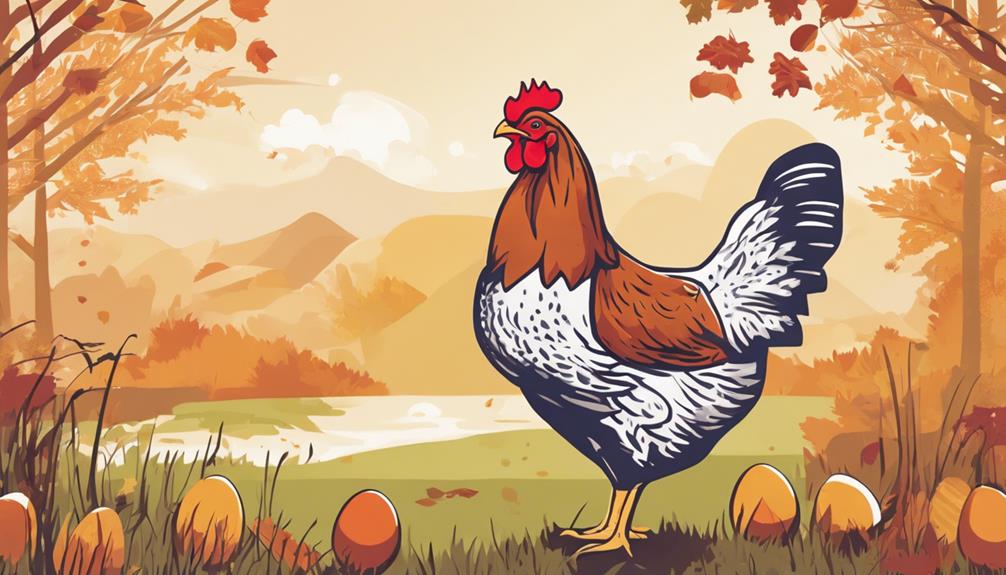In the days of yore, one might not have pondered how the capricious whims of weather affect the humble hen's egg production. Yet, as you navigate the complexities of modern poultry farming, it's crucial to recognize that factors like temperature extremes, humidity, and even the amount of daylight can significantly impact your flock's ability to lay eggs consistently.
Whether it's the scorching heat of summer or the unexpected chill of a spring frost, each weather condition holds sway over your hens' productivity.
As you explore further, you'll uncover strategies to mitigate these effects, ensuring your feathered friends continue to thrive regardless of the forecast.
Key Takeaways
- Extreme temperatures and humidity levels significantly reduce egg production and quality.
- Adequate shelter and ventilation are crucial to protect chickens from weather-related stress.
- Changes in daylight and seasonal shifts influence the egg-laying cycle and productivity.
- Proper management of water and feed intake is essential during temperature extremes to sustain egg production.
Temperature Extremes
When temperatures soar above 85ºF, hens experience heat stress, causing a significant drop in egg production by 15-40%. This isn't just about the heat; it's how their bodies react to it. As the mercury climbs, your hens' bodies work overtime to cool down, leading to a cascade of effects that hit egg production hard.
First off, their need for water skyrockets. You'll find they drink about 2.5 times more than usual. This isn't just to quench their thirst; it's a critical part of how they manage their body temperature and keep egg production going. If they're deprived of water, even for just 24-72 hours, the impact is severe and long-lasting. Their egg-laying mightn't bounce back for months.
Additionally, the intense heat messes with their calcium intake. Since calcium is vital for strong eggshells, you might notice the shells getting thinner. This isn't a sign of laziness on their part but a direct result of trying to cope with the environmental temperatures.
Humidity Effects
Just as extreme temperatures challenge hens in egg production, so too does high humidity, affecting everything from their feed intake to the quality of their eggs. High humidity levels can cause heat stress in laying hens, directly impacting their appetite and, ultimately, how many eggs they produce. This environmental condition doesn't just make the hens uncomfortable; it can significantly reduce their calcium intake, which is crucial for maintaining strong eggshell quality.
To ensure the wellbeing of your laying hens and the consistency of egg production, it's vital to monitor and manage humidity levels within poultry housing. Proper ventilation and humidity control are fundamental strategies to mitigate the adverse effects of high humidity.
Consider how these factors interplay:
- Heat stress from high humidity can make your hens eat less, affecting their overall health and productivity.
- Excessive humidity challenges calcium intake, crucial for sturdy eggshells.
- Environmental conditions like humidity must be optimized for hens to feel comfortable and remain productive.
- Effective ventilation systems are key in combating the dampness that high humidity brings.
Seasonal Changes

Seasonal shifts significantly influence your hens' egg production, with factors like reduced daylight in winter and sudden temperature changes impacting their laying patterns. As the daylight decreases, you'll notice a slowdown in egg production due to less light exposure.
It's not just the shorter days that affect your flock; even a quick drop in ambient temperature can lead to fewer eggs in your basket. Similarly, unexpected cold snaps are notorious for negatively affecting your hens' ability to lay.
Moreover, heavy cloud cover, often overlooked, can decrease egg production as well. Hens are quite sensitive to changes in natural light, and an overcast sky can mimic the shorter days of winter, tricking their bodies into slowing down. You might find that your hens stop laying altogether about a week after experiencing such bad weather or a significant temperature drop. This reaction is a testament to how tuned-in they're to their environment.
Changes in atmospheric pressures, especially before a storm, can further disrupt egg laying. These seasonal changes and weather impacts are vital to consider if you're aiming to understand and optimize your hens' egg production throughout the year.
Heat Stress Factors
While seasonal changes play a significant role in affecting your hens' egg production, it's also crucial to understand how heat stress factors can impact their laying patterns during warmer months. When ambient temperatures rise above 85ºF, poultry experience a 15-40% reduction in egg production. This is primarily due to heat stress, which forces hens to pant excessively, increasing CO2 production and resulting in thin eggshells. Moreover, to cope with the elevated body temperature, hens drink 2.5 times more water in hot weather, emphasizing the importance of constant water availability.
- Heat stress significantly reduces egg production and affects egg quality, leading to thinner eggshells.
- The lack of potable water during hot weather can halt egg laying entirely.
- Deprivation of water for 24-72 hours in hot conditions can have a lasting negative effect on egg production for weeks.
- Increased water intake is a clear sign of hens struggling to maintain a normal body temperature amidst high ambient temperatures.
Understanding these heat stress factors allows you to take preventive measures, ensuring your hens' well-being and sustaining egg production even during the warmest months.
Cold Stress Responses

In response to cold stress, chickens ramp up their metabolic rate to generate necessary warmth. This increase in metabolic activity is a crucial adaptation, but it has its trade-offs. As you're managing your flock through the colder months, it's vital to understand how cold stress affects them and what you can do to mitigate these effects.
| Impact of Cold Stress | Response & Management Strategy |
|---|---|
| Decreased Feed Intake | Ensure easy access to feed to encourage eating despite the cold. |
| Lowered Egg Production | Provide extra insulation and shelter to maintain production levels. |
| Huddling Behavior | Monitor for overcrowding and ensure there's enough space for all to huddle comfortably. |
| Eggshell Quality | Supplement calcium and provide adequate shelter to support calcium metabolism. |
Cold weather can lead to decreased feed intake, which in turn affects egg production. Chickens may also exhibit huddling behavior to conserve body heat, a natural response to maintain their optimal temperature. However, this cold stress can impact eggshell quality due to alterations in calcium metabolism. By providing adequate shelter, bedding, and insulation, you're not just making them comfortable; you're ensuring their body resources aren't overly taxed, supporting both their health and their productivity.
Rainfall and Light Access
Rainfall, along with its effect on light access, can significantly disrupt your hens' egg-laying routine by causing stress and creating uncomfortably wet conditions. When the skies open up, and the coop turns into a soggy mess, your laying hens mightn't just be uncomfortable; they could actually start laying fewer eggs. The ripple effect of rainfall on egg production can't be understated, as it leads to not just a drop in the number of eggs but potentially affects their quality too.
- Stress and Discomfort: Imagine being stuck in a cramped, damp space. That's how your hens feel during heavy rainfall, leading to stress that hinders their laying capabilities.
- Wet Conditions: Prolonged exposure to wet conditions can degrade egg quality, turning what should be a robust egg production operation into a struggle for survival.
- Interrupted Routines: Hens thrive on routine. Rainfall disrupts their normal activities, including laying, which can see your egg basket staying empty for longer than you'd like.
- Diminished Natural Light: Overcast skies and reduced daylight hours can throw off the egg-laying cycle, proving that managing shelter and ensuring enough light access is crucial during the rainy season.
Conclusion
In conclusion, you've seen how weather significantly influences your chicken's egg production. From scorching heat to chilling cold, and even the amount of sunlight they get, every weather condition plays a crucial role.
It's crucial to keep an eye on temperature extremes, humidity, and seasonal changes to protect your chickens from stress. By understanding these impacts and taking proactive measures, you'll ensure the well-being of your hens and maintain steady egg production, no matter what the weather throws at you.